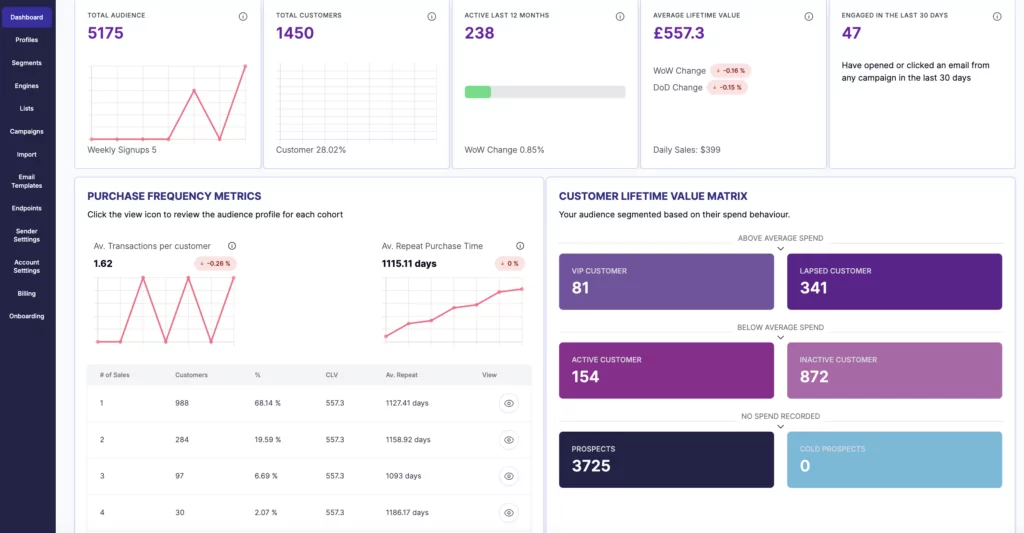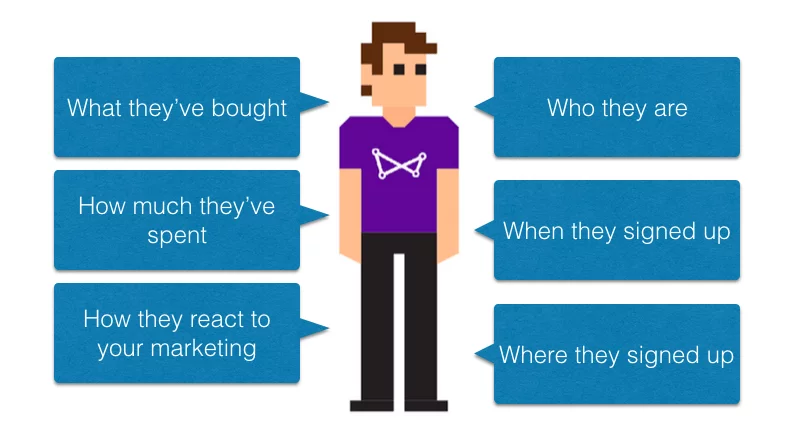Create a marketing strategy for your customer journey
When reviewing your marketing plans, reviewing your customer journeys are a great place to start. If that sounds confusing, simply think about what you want your audience to do, and then see what they actually do.
A lot is written about the strategic importance of understanding your customer journey, but if you are selling online, then your customer journey can be regarded as a living breathing thing, and the marketing of your customer journey cannot be underestimated.
Your marketing strategy needs to be able to react to opportunities as they appear. That means reacting to every sign up and to every sale.
It’s to make sure that your marketing activity is as relevant as possible to the behaviour of your customers.
And to make sure that your business generates the maximum customer lifetime value from every new customer that you sign up.
After all. You don’t just want your customers to buy once do you?
With Websand, all that key customer data you already hold is collated to help you understand the key points at every step of the customer journey.

With Websand, we take the heavy lifting away, so your data is managed just as you need it and you can focus on devising strategies that can really move your audience from prospects to repeat customers.
What’s a customer journey anyway?
A customer journey is a marketing term that’s used to describe the different routes and processes a customer could take with your business.
Let’s take the example of the processes involved in someone making a single sale. This may include the following steps…
The signup process. How does someone express interest in your business, what information do you ask them to provide.
The pre-sale process. Once someone has expressed interest, how do you encourage those people to purchase something from you.
The sales process. If you are in retail, – how does someone buy something from you. If you are in leisure – how does someone make a booking.
The follow-up process. Once someone has bought from you, what do you do next. Gather feedback? Sell them the next item?
That’s a taking a simplistic approach. Of course, every business wants a customer journey that guarantees that every person that signs up, will then buy something from you. And will then continue to buy from you until the end of time.
Unfortunately, that doesn’t happen always happen in real life, it’s can be more complex than that.
Marketing your customer journey
What does this actually mean?
Well, your job as a marketer is to generate the maximum opportunity from your audience. Let’s imagine you an e-commerce retailer that sells children’s socks, you have four areas of opportunity.
Search: People that are searching online to buy socks.
Let’s assume that in the most part these are people that ‘new’, so you’ll be using PPC, Social and SEO techniques to grab their attention. Your job is to make sure that if someone is looking for children’s socks, they will find you.
Converting the visitors to your site.
This is about converting visitors to useful data. Your job is to convert visitors to customers, or at the very least signups to your future email marketing.
Prospects to customers.
This is your first segment. People that have signed up to your marketing but have not yet bought from you. Your opportunity is to convert them from an interested person to an active customer. Not everyone that signs up for your email marketing will buy from you. So your job is to build a marketing process that creates the best chance of creating a new customer.
A word of caution, you’ll have limited information on your signup’s to start with so it’s likely to take some time to get right, but once you find a working process, you will unlock a new stream of revenue for your business.
Understanding your customers.
Here is where your customer journey gets really interesting.
You have knowledge about your audience. You know what and when they purchased and how many times they have bought from you, so based on that your job is to make sure you create the maximum number of opportunities based on their behaviour and the relationship between your business and the customer.

If someone is going to spend $1000 on children’s socks during their lifetime, it would make sense that you want them to spend that $1000 on the children’s socks you sell!
Why is marketing your customer journey so important
This is from a recent BBC article on the richest man in the World, Amancio Ortega, founder of Zara.
“[Amancio Ortega] did something quite unique. He set up with the ambition to give the customer what they want.
A lot of retail is [the company] deciding what they’ll want, manufacturing it and pushing it on the consumer“.
Instead, at Zara and sister brands the company listens to what its shop managers tell them – asking what are customers saying, what are they buying? And because Inditex manufactures, not in Asia, but in Spain, Portugal, Turkey and Morocco, it can react quickly, ordering more of popular products or changing styles.
It’s a pull model from the consumer rather than pushing the product onto the consumer”
Michelle Wilson, retail analyst at Berenberg – see full BBC article here
The same ‘pull’ model can be applied to the direct marketing part of your marketing strategy, especially with email marketing.
Instead of sending ‘company’ focused newsletters, focus on creating ‘customer focused’ email marketing with the content based around the behaviour of your customers.
When Websand users start using our marketing automation functions to market their customer journey, it’s no surprise that we see email marketing effectiveness increase often by over 300%.
And it’s not industry specific.
Like the 80/20 rule, or accounts, marketing can become process that can be applied to your business. All you need are the raw materials, customer data and a starting point.
That starting point is where your marketing customer journey begins.
Putting your marketing customer journey in place
We are well into our customer journey, and a big part of it is helping marketers figure out how they can adopt data driven marketing and manage the potential within their own marketing customer journey.
It can be challenging, but it’s always rewarding.
Start your customer journey with Websand.
We’ve helped hundreds of businesses plan out and implement customer journeys to boost engagement and generate new opportunities. If doesn’t matter if you are e-commerce, hospitality or B2B we can help.
All it takes is a couple of clicks to get started. Click here to sign up for a free trial or click on the calendar below and book some time with us.
